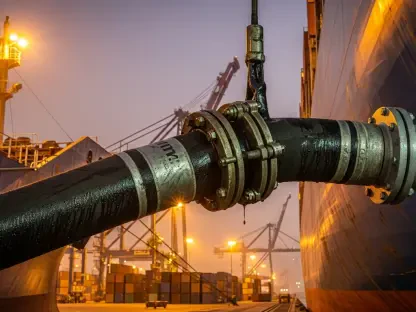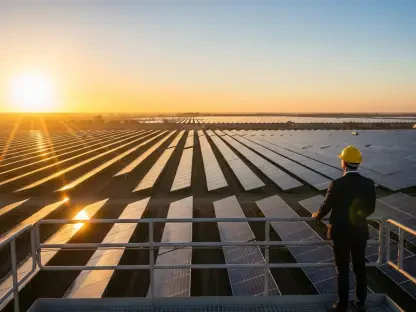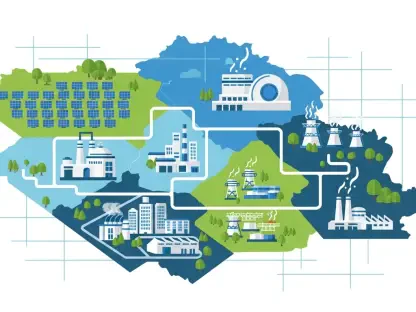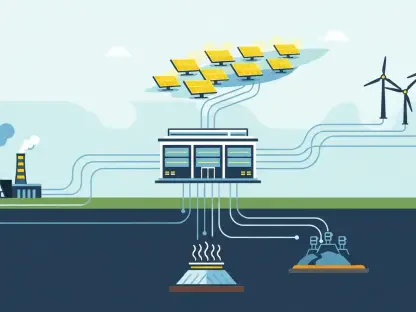What happens when the oil market flashes a deceptive grin while storm clouds of oversupply loom large on the horizon? In 2025, Brent crude prices paint an odd “smile” on the forward curve, suggesting confidence even as forecasts predict a glut of millions of barrels per day. This perplexing mismatch between market signals and hard data has traders on edge, teetering on the brink of potential financial ruin. The stakes are sky-high in this volatile arena, where a single miscalculation could wipe out profits overnight, pulling attention to a brewing crisis that demands scrutiny.
The significance of this anomaly stretches far beyond trading floors. Oil prices shape everything from household budgets to global inflation, making this disconnect a critical issue for economies worldwide. With agencies projecting a supply surplus through the coming years, understanding why the market appears unfazed is essential. This strange smile could signal either misplaced optimism or a calculated gamble, and unraveling its meaning may determine whether traders—and the broader economy—face triumph or turmoil in the months ahead.
Unmasking the Market’s Deceptive Grin
At first glance, the oil market seems calm, almost smug, with Brent crude’s forward curve displaying an unusual upward tilt that hints at stability. Yet beneath this serene façade lies a troubling reality: data from major energy bodies points to an oversupply that could flood the market with excess crude. This contradiction creates a high-stakes puzzle, where the apparent confidence of price signals clashes with warnings of a potential collapse, leaving traders to question what they can truly trust.
This peculiar curve shape, often dubbed a “smile” by analysts, starts with prompt prices higher than future ones—a state known as backwardation—before flattening and tipping into contango, where future prices exceed current ones. Such a pattern defies the logic of an oversupplied market, which typically leans toward contango to encourage storage. The risk here is clear: if fundamentals overpower sentiment, a sharp price drop could catch many off guard, turning that grin into a grimace.
Why the Oil Market’s Odd Smile Matters Now
The oil market is no mere financial niche; it serves as a backbone of global economic health, influencing costs from gasoline to goods on store shelves. A projected surplus, with production expected to outpace demand by over a million barrels daily in the near term, threatens to disrupt this balance. This imbalance could ripple through industries, spike inflation, or even strain geopolitical ties, making the current market signals a focal point for concern across multiple sectors.
Policymakers and consumers alike feel the weight of this issue, as energy costs directly impact daily life. If the market’s optimistic pricing proves misguided, a correction could lead to sudden price drops, affecting everything from transportation to manufacturing. The urgency to decode this anomaly lies in its potential to reshape economic forecasts, demanding attention from anyone tied to the global supply chain or energy-dependent systems.
Beyond immediate effects, the broader implications touch on long-term stability. A failure to address or anticipate the oversupply risks creating a cycle of volatility that undermines confidence in energy markets. As nations grapple with energy transitions and climate goals, the stakes of misreading these signals grow even higher, positioning this market smile as a critical test of foresight and adaptability.
Decoding the Disconnect: Oversupply vs. Market Signals
Diving into the numbers reveals a stark imbalance driving the current tension. Forecasts indicate global oil production climbing to unprecedented levels, with output projected at 105.5 million barrels per day (bpd) this year, while demand lags at 104.44 million bpd. This gap, expected to widen with a production surge of 4.1 million bpd in early 2026, paints a clear picture of excess supply that should, in theory, depress prices and shift market structures.
Yet the Brent forward curve tells a different tale, beginning in backwardation through mid-2026, flattening briefly, then slipping into contango. This unusual trajectory suggests either an expectation of tightness or a speculative bet against the forecasted glut, ignoring fundamentals like robust output from OPEC+ and non-OPEC players such as U.S. shale producers and Brazil. The disconnect raises red flags, as historical patterns show that ignoring such surpluses often leads to abrupt market corrections.
Key factors fueling this oversupply include aggressive production hikes from major players, coupled with tepid demand growth amid economic slowdowns in key regions. Non-OPEC nations continue to ramp up output, while OPEC+ shows reluctance to cut back, prioritizing market share over price stability. This structural mismatch, if unaddressed, risks flooding inventories and forcing a reckoning that the current curve seems unprepared to reflect.
Voices from the Field: Insights and Warnings
Expert analyses provide a sobering lens on the unfolding situation, with major energy agencies sounding alarms over inventory builds through 2027. Reports emphasize that without intervention, the surplus could overwhelm storage capacities, driving prices into a downward spiral. Such warnings carry weight, as they stem from rigorous data models tracking global supply and demand with pinpoint accuracy.
Industry voices echo these concerns, with seasoned analysts expressing doubt over quick fixes from key producers. Saudi Arabia, a linchpin of OPEC+, appears focused on securing market share rather than slashing output, a stance that complicates hopes for balance. This perspective, grounded in recent policy moves, suggests that any relief from oversupply may be slow to materialize, heightening the threat of a market shock.
A historical parallel brings the risk into sharp focus: during the 2014-2016 oil crash, traders misread similar curve signals, expecting stability only to face devastating losses as prices plummeted. One veteran trader recalled betting heavily on sustained backwardation, only to lose millions when the market flipped. Such stories serve as a stark reminder that today’s deceptive grin could herald a repeat of past financial pain if caution is sidelined.
Navigating the Risk: Strategies for Traders
For those in the trading game, the current uncertainty demands proactive measures to shield against a potential price freefall. Keeping a close watch on OPEC+ decisions remains paramount, as even subtle hints of production cuts could reshape the forward curve overnight. Saudi Arabia’s statements, in particular, warrant scrutiny, given its outsized influence on group policy and market direction.
Hedging offers another vital tool, with futures contracts providing a way to lock in prices and guard against a shift to contango. Adjusting portfolios to prioritize fundamental data over fleeting sentiment is equally crucial; tracking weekly inventory updates can signal stock builds before they hit the broader market. Such steps, while technical, form a critical buffer against sudden downturns that could push Brent below $60 per barrel, a threshold breached in recent slides from $73 to $66.
Diversification stands as a final safeguard, urging traders to spread exposure beyond oil into other commodities or sectors less tied to energy gluts. This approach mitigates the impact of a sustained oversupply scenario, offering a lifeline if market fundamentals eventually prevail. By blending vigilance with strategic planning, traders can navigate the treacherous smile of today’s oil curve, turning potential tears into calculated resilience.
Looking back, the oil market’s deceptive smile in 2025 stood as a stark warning of the volatility that defined trading in an era of oversupply. Reflecting on that period, the path forward became clearer through a commitment to data-driven decisions over blind optimism. Traders who adapted by prioritizing inventory trends and hedging strategies often emerged stronger, while others learned hard lessons from ignoring the fundamentals. Moving ahead, the industry needed to foster tighter collaboration between producers and analysts to anticipate gluts before they spiraled, ensuring that future market signals aligned more closely with reality. Embracing technological tools for real-time supply tracking also promised to sharpen responses, offering a proactive shield against the next deceptive grin.









